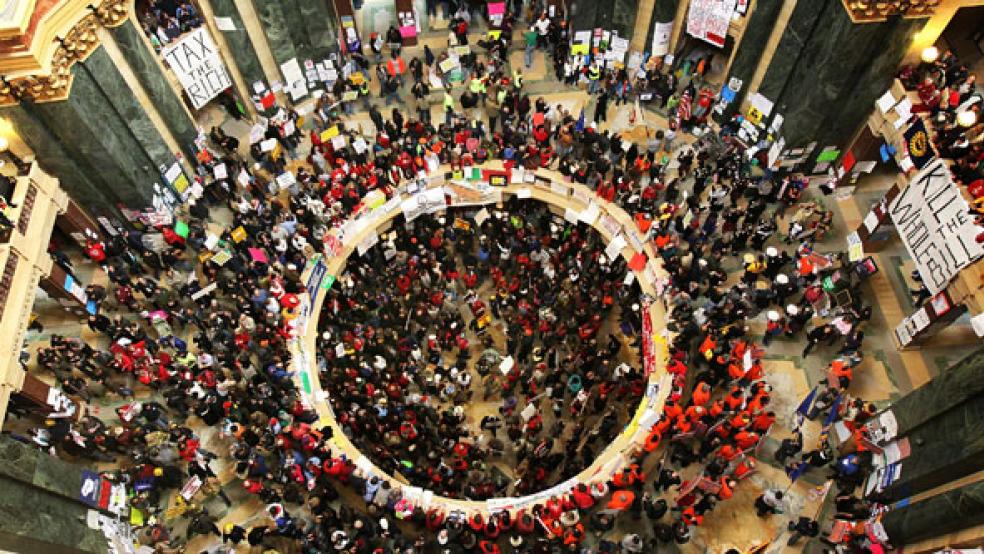Over the past few decades, the future has become increasingly uncertain for workers in the U.S. They can no longer count upon a relatively secure job with a single employer, an automaker perhaps. They can no longer depend on their wages rising over time with increases in productivity. Their employer-provided health and retirement benefits — if they have them — could end at any time. And one of the basic building blocks for a better future, education, is becoming harder and harder for middle class families to afford. Even those who can afford an education are less secure than in the past as digital technology advances at a rapid pace and the world becomes increasingly globalized. Lately, on top of everything else, workers have been warned that the age of innovation is over, the great stagnation is here, and they must accept a diminished outlook for the future.
It’s no wonder, then, that the attempt by Wisconsin Governor Scott Walker to take away the collective bargaining rights of public employees has reignited a long-standing debate over unions. What role do unions play in making sure that workers receive a fair share of the output they produce, in assuring that production takes place in a safe work environment, and in helping extract health and retirement benefits from employers? Can the wage stagnation and decline in job benefits that workers have experienced since the 1970s be traced to the decline of unions?
The attempt to strip public unions of their power in Wisconsin, Indiana and other places is related to the more general decline in unions over the last several decades. In the past, public-sector unions were viewed as part of the overall union effort. They provided a positive spillover effect to the private sector in terms of higher benefits, better wages and better working conditions. Public-sector benefits, for example, set an important benchmark for private-sector unions and for private-sector workers in general. Workers could point to the public sector and say: “I want what they have.”
But as private-sector unions declined and workers lost many of those benefits, as the chance of getting “what they have” has all but gone away, the idea that the typical household is helped indirectly by public-sector unions has been harder to swallow. That has made it much easier to pit workers in the private sector — workers who are also voters — against unionized workers in the public sector. “Why should I pay for what they have if I can’t have it myself” has replaced the idea that the public-sector unions can help forge the way for workers in the private sector. This successful divide-and-conquer strategy has broken the solidarity between the two groups. And though the protests in Wisconsin may be reestablishing these ties, the change is likely to be temporary and the longer-run outlook for unions of all types is not very bright.
How much has been lost as unions have faded? There is disagreement over the degree to which the decline in unions can explain the stagnating wages and rising inequality America has experienced since the 1970s. Many people point to factors such as increased rewards to skilled labor arising from technological change, or to superstar effects that have been magnified by globalization as more important factors.
But it doesn’t really matter who is correct. Unions may have been the answer at one time, but the world has changed since the 1970s. In today’s increasingly globalized world where private-sector companies can easily move production to escape unions, where unionized jobs are disappearing because of technological change, and where states are passing laws to reduce power the power of organized labor, unions are losing their influence (the difficulty of moving government services to other states or other countries helps explain why public unions have tended to outlast their private-sector counterparts). And it hasn’t helped that the political environment, beginning with the Reagan administration in the 1970s in particular, has become increasingly unfriendly. There was hope that the election of President Obama would change the political climate and help to reverse the decline of unions, but that hope is being dashed by the recession, by the loss of the House to Republicans in the last election, and by the political gains Republicans have made at the state level.
If unions aren’t the answer in a global economy, then what is? Will global labor organizations replace domestic unions? Perhaps someday, but this would require global institutions that do not presently exist, and that do not look likely to materialize anytime soon.
The only institution powerful enough to protect workers now is government. By providing the things unions once fought for on behalf of workers, government can help to correct inequities and reduce the insecurity workers face. Ensuring that working-class households have the health and dental care they need, security in old age, a safe place to work, insurance against job loss, higher education that is essentially free, and the benefits of a tax policy that redistributes income so economic gains are shared more equitably would go a long way toward remedying what workers have lost since the 1970s. We’ve made a start on health care, but there is much, much more to be done.
However, it’s hard to be optimistic that any of this will actually happen. Budget problems and political realities make it unlikely that government will provide new benefits or engage in substantial redistribution. In fact, with the way things look these days, working-class households will be lucky to keep what they already have.
Related Links:
Pols turn on labor unions (Politico)
Public Workers Aren't Walker's Only Target (The New Republic)






